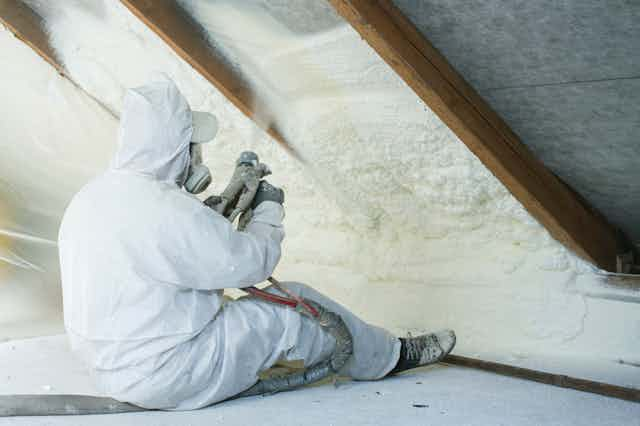Buildings are designed to keep people safe and comfortable according to the local climate: warm when it’s cold outside, dry when it’s wet and sheltered when it’s stormy. If the climate changes, buildings may struggle to serve our needs in the new conditions. The UK’s recent 40°C heatwave showed that many existing structures – especially the homes where we spend two-thirds of our lives – aren’t up to the task.
Older people with existing health problems are among the most vulnerable during hot weather, as the heat can exacerbate potentially fatal conditions such as respiratory and heart diseases and even Alzheimer’s. An early estimate suggests as many as 1,000 excess deaths may have occurred in England and Wales as a result of the three-day heatwave in mid-July 2022.
Read more: Heatwaves can kill – research uncovers the homes most vulnerable to overheating
Each country must upgrade its buildings to keep people safe as the world warms. This is part of what climate change experts call adaptation. The other half of that obligation is mitigation: cutting emissions as fast possible to minimise the temperature increase. By adapting homes to withstand stronger heatwaves, countries have an opportunity to meet both needs at the same time.
You will have heard some of the solutions for decarbonising buildings: increased roof and wall insulation and double-glazed windows for energy efficiency, and replacing gas boilers with alternatives such as heat pumps which can run on renewable electricity. These same measures will also help people stay safe during future heatwaves.
Just as better insulation keeps warm air inside during winter, it keeps it outside during summer. Shutters or blinds that block sunlight are a simple option for lowering indoor temperatures by keeping out even more heat. It even helps to paint roofs a light colour to better reflects the sun’s rays. In the Australian state of New South Wales, a policy to completely ban dark-coloured roofs was recently considered.

Most homes in the UK are heated with gas boilers but have no equivalent system for cooling. Heat pumps can help. These machines are essentially refrigerators working backwards. Where a fridge sucks heat from its interior and disperses it through the coils on its back, a heat pump sucks the heat from the air (or ground) outside and transfers it to the inside of your house to keep you warm in winter. The process runs on electricity, so it does this without needing to burn gas.
Heat pumps can be programmed to work a reverse cycle, allowing them to pump cold water rather than hot water through the radiators to cool your house in summer. But this cooling cycle has to be built into the heat pump system when it’s installed – it’s not as simple as flicking a switch. Unfortunately, the UK government offers little guidance. The Energy Saving Trust, a government body tasked with making homes more energy efficient, neglects even to mention in its guide to heat pumps that they are capable of cooling.
The rate at which heat pumps are installed almost doubled during 2021 in the UK. As a result, there will be many homes with new heat pumps, funded with public subsidies, that can only provide heating.

Better homes overall
This lack of foresight in national responses to climate change is frustrating. Insulating buildings would help permanently lower energy bills for millions, but the UK government has starved energy efficiency measures of resources over the past decade. Recently, plans were abandoned that would have doubled funding for low-income housesholds to become more energy efficient. Meanwhile, the UK’s newly built homes suffer from much of the same poor insulation as older ones.
Some countries are being more proactive. Italian homeowners can claim 110% of the cost of energy efficiency improvements against their taxes, up to €100,000 (£84,000) over five years. That is more than enough to upgrade a house to net-zero standard, estimated at £26,000 in the UK.
If homes need less energy to heat or cool because they have been made more energy efficient, it would help reduce (and perhaps even eradicate) fuel poverty. If they are able to maintain comfortable indoor temperatures and air quality through better ventilation, they can better accommodate people working or learning from home should there be another pandemic.
And, if the technology is powered by a dispersed renewable energy network, comprised of rooftop solar panels feeding excess energy to the grid, society will be more resilient to future spikes in the price of energy. Beyond any benefits these actions might have for tackling climate change, they simply reflect the reality of modern life.
The solutions are simple, but implementing them will be complex – all countries must coordinate their responses more effectively. A lot of money, both public and private, will be spent on cutting emissions to net zero. Unless countries plan for adapting to rising temperatures at the same time, the opportunity for more comfortable, resilient and liveable homes will be lost.

Don’t have time to read about climate change as much as you’d like?
Get a weekly roundup in your inbox instead. Every Wednesday, The Conversation’s environment editor writes Imagine, a short email that goes a little deeper into just one climate issue. Join the 10,000+ readers who’ve subscribed so far.

